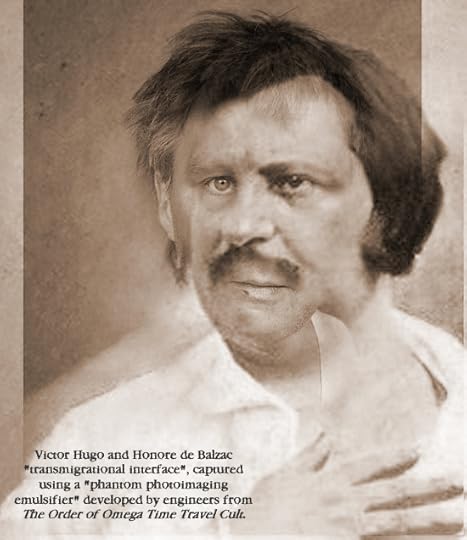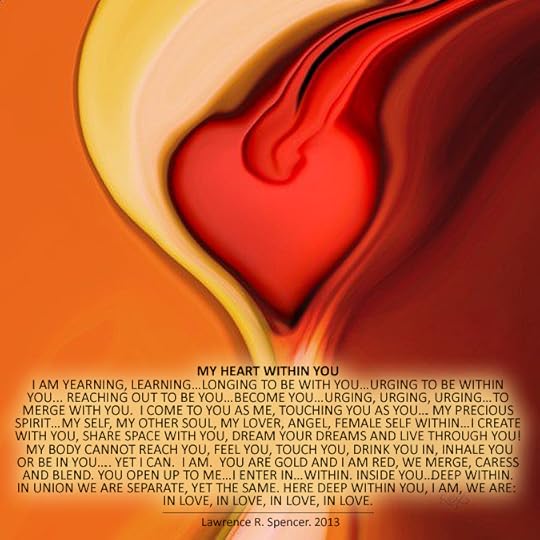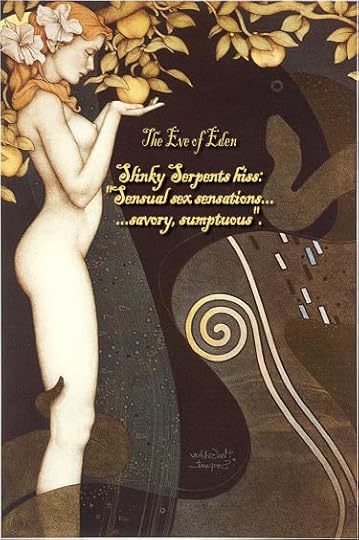Lawrence R. Spencer's Blog, page 361
April 7, 2018
SERENITY
INTERNET: HOGS and WHORES
April 4, 2018
TRANSMIGRATIONAL INTERFACE
Helen deMurier, Secretary of the Paris, France Chapter of the Order of Omega Time Travel Cult, was recently dispatched on an assignment to investigate the apparent merging of the French writer Honor de Balzac in a rare philosophical convergence with another famous French author, his friend, Victor Hugo. The above image was recorded of when the two disembodies spirits of these men apparently “merged” during a rare “transmigrational interface” which was recorded by a device developed by The Omega Time Travel Cult engineering department. The engineers were able to capture this unique event at the instant of it’s occurrance using a new invention they named the “phantom photoimaging emulsifier”.
In order to verify the apparent “merge” Helen returned in time to the home of Honor de Balzac, who died on 18 August 1850. Coincidently, she discovered, he was visited on that day by his friend Victor Hugo, who was a French poet, playwright, novelist, essayist, visual artist, statesman, human rights activist and exponent of the Romantic movement in France. (Outside France, Victor’s best-known works are the novels Les Misrables and Notre-Dame de Paris (also known in English as The Hunchback of Notre-Dame).
Victor confided to Helen that Balzac had always concerned himself overwhelmingly with the darker essence of human nature and the corrupting influence of middle and high societies. He believed that “Behind every great fortune lies a great crime. I do not regard a broker as a member of the human race.”
Victor lived until 22 May 1885, when he finally passed at the age of 83. His death generated intense national mourning inasmuch as he had always been a champion of the common man and outspoken enemy of repression by the church and governments. He wrote, “Emergencies have always been necessary to progress. It was darkness which produced the lamp. It was fog that produced the compass. It was hunger that drove us to exploration. And it took a depression to teach us the real value of a job.”
According to the official report filed by Helen, who continued to track the disembodied personalities of the two men through time to the present moment, both men have — individually and serparately — continued on their paths in the afterlife, and are now thriving comfortably in their new human forms. Victor is lives in Chicago and works as a producer for the OWN TV network. Honre is currently a student attending the University of Michigan, majoring in Classic French literature.
Thank you for your report Helen!
Originally posted 2011-10-21 16:36:28. Republished by Blog Post Promoter
GENGHIS KHAN: HISTORY REVISED
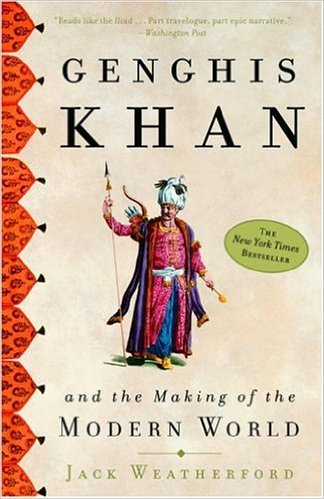 “The Mongol army led by Genghis Khan subjugated more lands and people in twenty-five years than the Romans did in four hundred. In nearly every country the Mongols conquered, they brought an unprecedented rise in cultural communication, expanded trade, and a blossoming of civilization. Vastly more progressive than his European or Asian counterparts, Genghis Khan abolished torture, granted universal religious freedom, and smashed feudal systems of aristocratic privilege. From the story of his rise through the tribal culture to the explosion of civilization that the Mongol Empire unleashed, this brilliant work of revisionist history is nothing less than the epic story of how the modern world was made.” – (publisher’s note)
“The Mongol army led by Genghis Khan subjugated more lands and people in twenty-five years than the Romans did in four hundred. In nearly every country the Mongols conquered, they brought an unprecedented rise in cultural communication, expanded trade, and a blossoming of civilization. Vastly more progressive than his European or Asian counterparts, Genghis Khan abolished torture, granted universal religious freedom, and smashed feudal systems of aristocratic privilege. From the story of his rise through the tribal culture to the explosion of civilization that the Mongol Empire unleashed, this brilliant work of revisionist history is nothing less than the epic story of how the modern world was made.” – (publisher’s note)
I found this book to be a highly illuminating examination of the actions and influences Mongolian conquest and civilizing influences of Genghis Khan during his brilliant administration of the largest empire ever established on Earth. In the West almost nothing is known about Genghis Khan and the civilization he and his family built. He has been villainized and marginalized through misinformation and disinformation of western “scholars” who serve the vested interests of European church and state to defend and protect their power and control. This book is a marvelously well written revisionist history of the Khan Dynasty based on recent scholarship with access to the previously forbidden materials from China and Mongolia. – LRS
Originally posted 2016-03-01 13:35:13. Republished by Blog Post Promoter
April 3, 2018
ELECTRIC MONKS BELIEVE FOR YOU
 There are too many people on TV and the Internet demanding that we “believe” their version of “reality”, all of which are divergent, conflicting, self-contradictory, self-serving, or absurd. So, why waste your time and attention on “believing” anything when there is an ingenious labor-saving device called: The Electric Monk
There are too many people on TV and the Internet demanding that we “believe” their version of “reality”, all of which are divergent, conflicting, self-contradictory, self-serving, or absurd. So, why waste your time and attention on “believing” anything when there is an ingenious labor-saving device called: The Electric Monk
(VIDEO CLIP BELOW NARRATED BY DOUGLAS ADAMS)
(from Dirk Gently’s Holistic Detective Agency by Douglas Adams)
“High on a rocky promontory sat an Electric Monk on a bored horse. From under its rough woven cowl the Monk gazed unblinkingly down into another valley, with which it was having a problem.
The day was hot, the sun stood in an empty hazy sky and beat down upon the gray rocks and the scrubby, parched grass. Nothing moved, not even the Monk. The horse’s tail moved a little, swishing slightly to try and move a little air, but that was all. Otherwise, nothing moved.
The Electric Monk was a labour-saving device, like a dishwasher or a video recorder. Dishwashers washed tedious dishes for you, thus saving you the bother of washing them yourself, video recorders watched tedious television for you, thus saving you the bother of looking at it yourself; Electric Monks believed things for you, thus saving you what was becoming an increasingly onerous task, that of believing all the things the world expected you to believe.
Unfortunately this Electric Monk had developed a fault, and had started to believe all kinds of things, more or less at random. It was even beginning to believe things they’d have difficulty believing in Salt Lake City. It had never heard of Salt Lake City, of course. Nor had it ever heard of a quingigillion, which was roughly the number of miles between this valley and the Great Salt Lake of Utah.
The problem with the valley was this. The Monk currently believed that the valley and everything in the valley and around it, including the Monk itself and the Monk’s horse, was a uniform shade of pale pink. This made for a certain difficulty in distinguishing any one thing from any other thing, and therefore made doing anything or going anywhere impossible, or at least difficult and dangerous. Hence the immobility of the Monk and the boredom of the horse, which had had to put up with a lot of silly things in its time but was secretly of the opinion that this was one of the silliest.
How long did the Monk believe these things?
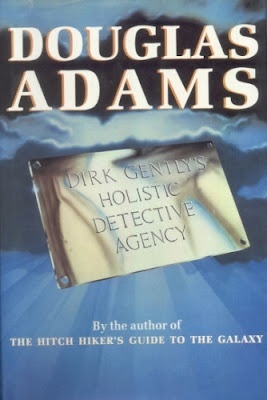 Well, as far as the Monk was concerned, forever. The faith which moves mountains, or at least believes them against all the available evidence to be pink, was a solid and abiding faith, a great rock against which the world could hurl whatever it would, yet it would not be shaken. In practice, the horse knew, twenty-four hours was usually about its lot.
Well, as far as the Monk was concerned, forever. The faith which moves mountains, or at least believes them against all the available evidence to be pink, was a solid and abiding faith, a great rock against which the world could hurl whatever it would, yet it would not be shaken. In practice, the horse knew, twenty-four hours was usually about its lot.
So what of this horse, then, that actually held opinions, and was sceptical about things? Unusual behaviour for a horse, wasn’t it? An unusual horse perhaps?
No. Although it was certainly a handsome and well-built example of its species, it was none the less a perfectly ordinary horse, such as convergent evolution has produced in many of the places that life is to be found. They have always understood a great deal more than they let on. It is difficult to be sat on all day, every day, by some other creature, without forming an opinion on them.
On the other hand, it is perfectly possible to sit all day, every day, on top of another creature and not have the slightest thought about them whatsoever.
When the early models of these Monks were built, it was felt to be important that they be instantly recognisable as artificial objects. There must be no danger of their looking at all like real people. You wouldn’t want your video recorder lounging around on the sofa all day while it was watching TV. You wouldn’t want it picking its nose, drinking beer and sending out for pizzas.
So the Monks were built with an eye for originality of design and also for practical horse-riding ability. This was important. People, and indeed things, looked more sincere on a horse. So two legs were held to be both more suitable and cheaper than the more normal primes of seventeen, nineteen or twenty-three; the skin the Monks were given was pinkish-looking instead of purple, soft and smooth instead of crenellated. They were also restricted to just one mouth and nose, but were given instead an additional eye, making for a grand total of two. A strange looking creature indeed. But truly excellent at believing the most preposterous things.
This Monk had first gone wrong when it was simply given too much to believe in one day. It was, by mistake, cross-connected to a video recorder that was watching eleven TV channels simultaneously, and this caused it to blow a bank of illogic circuits. The video recorder only had to watch them, of course. It didn’t have to believe them as well. This is why instruction manuals are so important.
So after a hectic week of believing that war was peace, that good was bad, that the moon was made of blue cheese, and that God needed a lot of money sent to a certain box number, the Monk started to believe that thirty-five percent of all tables were hermaphrodites, and then broke down. The man from the Monk shop said that it needed a whole new motherboard, but then pointed out that the new improved Monk Plus models were twice as powerful, had an entirely new multi-tasking Negative Capability feature that allowed them to hold up to sixteen entirely different and contradictory ideas in memory simultaneously without generating any irritating system errors, were twice as fast and at least three times as glib, and you could have a whole new one for less than the cost of replacing the motherboard of the old model.
That was it. Done.
The faulty Monk was turned out into the desert where it could believe what it liked, including the idea that it had been hard done by. It was allowed to keep its horse, since horses were so cheap to make.
For a number of days and nights, which it variously believed to be three, forty-three, and five hundred and ninety-eight thousand seven hundred and three, it roamed the desert, putting its simple Electric trust in rocks, birds, clouds, and a form of non-existent elephant-asparagus, until at last it fetched up here, on this high rock, overlooking a valley that was not, despite the deep fervour of the Monk’s belief, pink. Not even a little bit.
Time passed.”
Originally posted 2015-07-18 21:29:01. Republished by Blog Post Promoter
April 2, 2018
BIONEERING
“You will find “evolution” mentioned in the ancient Vedic Hymns. (Footnote) The Vedic texts are like folk tales or common wisdoms and superstitions gathered throughout the systems of The Domain. These were compiled into verses, like a book of rhymes. For every statement of truth, the verses contain as many half-truths, reversals of truth and fanciful imaginings, blended without qualification or distinction.
The theory of evolution assumes that the motivational source of energy that animates every life form does not exist. It assumes that an inanimate object or a chemical concoction can suddenly become “alive” or animate accidentally or spontaneously. Or, perhaps an electrical discharge into a pool of chemical ooze will magically  spawn a self-animated entity.
spawn a self-animated entity.
There is no evidence whatsoever that this is true, simply because it is not true. Dr. Frankenstein did not really resurrect the dead into a marauding monster, except in the imagination of the IS-BE who wrote a fictitious story one dark and stormy night. (Footnote)
No Western scientist ever stopped to consider who, what, where, when or how this animation happens. Complete ignorance, denial or unawareness of the spirit as the source of life force required to animate inanimate objects or cellular tissue is the sole cause of failures in Western medicine.
 In addition, evolution does not occur accidentally. It requires a great deal of technology which must be
ma
nipulated under the careful supervision of IS-BEs. Very
simple examples are seen in the modification of farm animals or in the breeding of dogs. However, the notion that human biological organisms evolved naturally from earlier ape-like forms is incorrect. No physical evidence will ever be uncovered to substantiate the notion that modern humanoid bodies evolved on this planet.
In addition, evolution does not occur accidentally. It requires a great deal of technology which must be
ma
nipulated under the careful supervision of IS-BEs. Very
simple examples are seen in the modification of farm animals or in the breeding of dogs. However, the notion that human biological organisms evolved naturally from earlier ape-like forms is incorrect. No physical evidence will ever be uncovered to substantiate the notion that modern humanoid bodies evolved on this planet.
The reason is simple: the idea that human bodies evolved spontaneously from the primordial ooze of chemical interactivity in the dim mists of time is nothing more than a hypnotic lie instilled by the amnesia operation to prevent your recollection of the true origins of Mankind. Factually, humanoid bodies have existed in various forms throughout the universe for trillions of years.”
— excerpt from the Top Secret interview transcripts published in the book ALIEN INTERVIEW
[i] “… you will find “evolution” mentioned in the ancient Vedic Hymns…”
“The Vedas are very exhaustive scriptures. Each Veda contains several sections and thousands of hymns. Some of the Vedic hymns, especially the hymns of the Rig Veda, are considered to be at least 6000-8000 years old. The Vedas are believed to be revealed scriptures, because they are considered to be divine in origin. Since they were not written by any human beings but were only heard in deep meditative states, they are commonly referred as srutis or those that were heard.” — Reference: http://www.hinduwebsite.com/vedicsect...
“The Vedas (Sanskrit véda वेद “knowledge”) are a large corpus of texts originating in Ancient India. They form the oldest layer of Sanskrit literature and the oldest sacred texts of Hinduism. According to Hindu tradition, the Vedas are “not human compositions”, being supposed to have been directly revealed, and thus are called śruti (“what is heard”). Vedic mantras are recited at Hindu prayers, religious functions and other auspicious occasions.
Philosophies and sects that developed in the Indian subcontinent have taken differing positions on the Vedas. Schools of Indian philosophy which cite the Vedas as their scriptural authority are classified as “orthodox” (āstika). Other traditions, notably Buddhism and Jainism, though they are (like the vedanta) similarly concerned with liberation did not regard the Vedas as divine ordinances but rather human expositions of the sphere of higher spiritual knowledge, hence not sacrosanct.”
— Reference: Wikipedia.org
[ii] “… the IS-BE who wrote a fictitious story one dark and stormy night…”
Frankenstein: or, The Modern Prometheus is a novel written by the British author Mary Shelley. Shelley wrote the novel when she was 18 years old. The first edition was published anonymously in London in 1818. Shelley’s name appears on the revised third edition, published in 1831. The title of the novel refers to a scientist, Victor Frankenstein, who learns how to create life and creates a being in the likeness of man, but larger than average and more powerful.
The story has had an influence across literature and popular culture and spawned a complete genre of horror stories and films. It is arguably considered the first fully realized science fiction novel. The novel raises many issues that can be linked to today’s society.
During the rainy summer of 1816, the “Year Without a Summer,” the world was locked in a long cold volcanic winter caused by the eruption of Mount Tambora in 1815. Mary Wollstonecraft Godwin, age 19, and her lover (and later husband) Percy Bysshe Shelley, visited Lord Byron at the Villa Diodati by Lake Geneva in Switzerland. The weather was consistently too cold and dreary that summer to enjoy the outdoor holiday activities they had planned, so the group retired indoors until almost dawn talking about science and the supernatural. After reading Fantasmagoriana, an anthology of German ghost stories, they challenged one another to each compose a story of their own, the contest being won by whoever wrote the scariest tale.
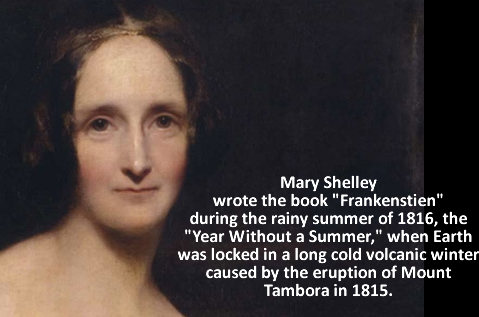 Mary conceived an idea after she fell into a waking dream or nightmare during which she saw “the pale student of unhallowed arts kneeling beside the thing he had put together.” Byron managed to write just a fragment based on the vampire legends he heard while travelling the Balkans, and from this Polidori created The Vampyre (1819), the progenitor of the romantic vampire literary genre. Two legendary horror tales originated from this one circumstance.
Mary conceived an idea after she fell into a waking dream or nightmare during which she saw “the pale student of unhallowed arts kneeling beside the thing he had put together.” Byron managed to write just a fragment based on the vampire legends he heard while travelling the Balkans, and from this Polidori created The Vampyre (1819), the progenitor of the romantic vampire literary genre. Two legendary horror tales originated from this one circumstance.
Radu Florescu, in his book In Search of Frankenstein, argued that Mary and Percy Shelley visited Castle Frankenstein on their way to Switzerland, near Darmstadt along the Rhine, where a notorious alchemist named Konrad Dippel had experimented with human bodies.”
— Reference: Wikipedia.org
Originally posted 2015-04-08 18:03:18. Republished by Blog Post Promoter
April 1, 2018
MY HEART WITHIN YOU
MY HEART WITHIN YOU
I AM YEARNING, LEARNING… LONGING TO BE WITH YOU… URGING TO BE WITHIN YOU… REACHING OUT TO BE YOU… BECOME YOU… URGING, URGING, URGING… TO MERGE WITH YOU. I COME TO YOU AS ME, TOUCHING YOU AS YOU…. MY PRECIOUS SPIRIT… MY SELF, MY OTHER SOUL, MY LOVER, ANGEL, FEMALE SELF WITHIN… I CREATE WITH YOU, SHARE SPACE WITH YOU, DREAM YOUR DREAMS AND LIVE THROUGH YOU! MY BODY CANNOT REACH YOU, FEEL YOU, TOUCH YOU, DRINK YOU IN, INHALE YOU OR BE IN YOU….. YET I CAN. I AM. YOU ARE GOLD AND I AM RED, WE MERGE, CARESS AND BLEND. YOU OPEN UP TO ME… I ENTER IN… WITHIN. INSIDE YOU…DEEP WITHIN. IN UNION WE ARE SEPARATE, YET THE SAME. HERE DEEP WITHIN YOU, I AM, WE ARE:
IN LOVE, IN LOVE, IN LOVE, IN LOVE.
_______________________________
Lawrence R. Spencer. 2013
Originally posted 2013-03-05 23:40:58. Republished by Blog Post Promoter
March 31, 2018
THE NATIVE PEOPLE
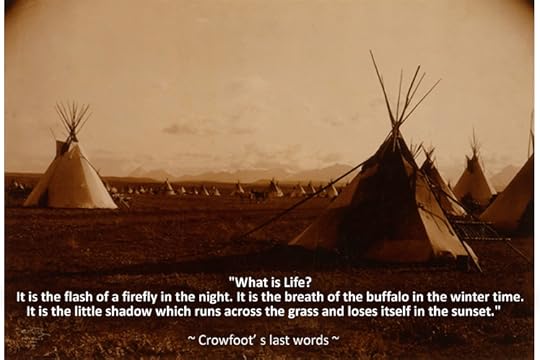 “What is Life? It is the flash of a firefly in the night. It is the breath of the buffalo in the winter time. It is the little shadow which runs across the grass and loses itself in the Sunset.” ~ Crowfoot’s last words
“What is Life? It is the flash of a firefly in the night. It is the breath of the buffalo in the winter time. It is the little shadow which runs across the grass and loses itself in the Sunset.” ~ Crowfoot’s last words
SEE ALL EDWARD CURTIS PHOTOS OF INDIGENOUS PEOPLE OF CENTRAL & WESTERN NORTH AMERICA FROM 1900 A.D.
“Edward Curtis’s brief expedition to the Great Plains in the summer of 1900 was undoubtedly the most profound experience of his life. That summer, Curtis accompanied George Bird Grinnell, his friend and early mentor, on a trip to Montana and witnessed one of the last great enactments of the Sun Dance. As Curtis viewed the Sun Dance—a ceremony that few whites, or natives, would see again for nearly seven decades—his vision for the grand photo-ethnographic undertaking that would become his life’s work crystallized. The small body of images he made on that summer trip, among them The Three Chiefs, Piegan Dandy, and Piegan Encampment, clearly reveal that he had been touched by the magnificence of the Indian nations and the overwhelming depth of their culture. These photographs formed the beginning of the vast, elegant portrait of Native American cultures that Curtis would bring to the world over the next thirty years.
During Curtis’s time, the Indians of the Great Plains lived primarily in North and South Dakota, Montana, and Wyoming, a territory once traversed by great herds of migrating buffalo. Curtis was strongly attracted to the fiercely independent lifestyle of tribes such as the Lakota, Apsaroke, and Piegan and seemed particularly adept at transforming their dignity and pride into extraordinary photographic images.
Curtis’s photographs of Indian life on the Great Plains comprise perhaps his most popular body of work; for many people, his photographs of the chiefs and warriors, the beadwork, the horses, and the Plains landscape have come to exemplify the American Indian. However, his photographs of the Plains Indians also documented many other aspects of tribal cultural life, including hunting, warfare, vision quests, and religious ceremonies. These images remain an unparalleled vision of the strength and nobility of the Plains Indian peoples who had once held dominion over tens of thousands of square miles.”
SEE ALL EDWARD CURTIS PHOTOS OF INDIGENOUS PEOPLE OF CENTRAL & WESTERN NORTH AMERICA FROM 1900 A.D.
http://www.edwardcurtis.com/tribal-regions/
Originally posted 2016-01-04 15:46:26. Republished by Blog Post Promoter
ETERNAL NOW
Alan Wilson Watts (6 January 1915 – 16 November 1973) was a British-born philosopher, writer, and speaker, best known as an interpreter and populariser of Eastern philosophy for a Western audience. Born in Chislehurst, he moved to the United States in 1938 and began Zen training in New York. Pursuing a career, he attended Seabury-Western Theological Seminary, where he received a master’s degree in theology. Watts became an Episcopal priest but left the ministry in 1950 and moved to California, where he joined the faculty of the American Academy of Asian Studies.
Living on the West Coast, Watts gained a large following in the San Francisco Bay Area while working as a volunteer programmer at KPFA, a Pacifica Radio station in Berkeley. Watts wrote more than 25 books and articles on subjects important to Eastern and Western religion, introducing the then-burgeoning youth culture to The Way of Zen (1957), one of the first bestselling books on Buddhism. In Psychotherapy East and West (1961), Watts proposed that Buddhism could be thought of as a form of psychotherapy and not a religion. He also explored human consciousness, in the essay “The New Alchemy” (1958), and in the book The Joyous Cosmology (1962).
Originally posted 2013-05-12 00:01:59. Republished by Blog Post Promoter
March 30, 2018
Eve of Eden
Painting: “The Golden Serpent” (2000) Copyright © by Michael Parkes
Originally posted 2010-12-02 11:23:06. Republished by Blog Post Promoter



